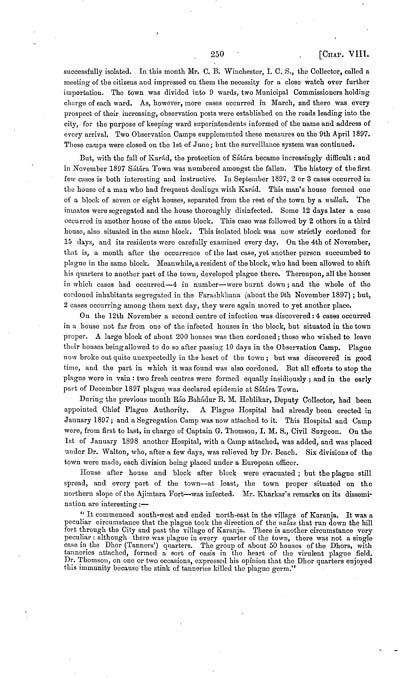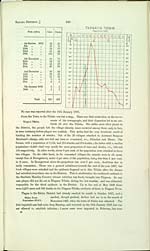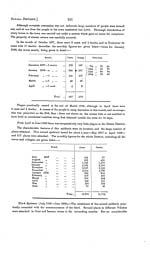Medicine - Disease > Bombay plague: being a history of the progress of plague in the Bombay presidency from September 1896 to June 1899
(322) Page 250
Download files
Individual page:
Thumbnail gallery: Grid view | List view

250 [CHAP. VIII.
successfully isolated. In this month. Mr. C. B. "Winchester, I. C. S., the Collector, called a
meeting of the citizens and impressed on them the necessity for a close watch over further
importation. The town was divided into 9 wards, two Municipal Commissioners holding
charge of each ward. As, however, more cases occurred in March, and there was every
prospect of their increasing, observation posts were established on the roads leading into the
city, for the purpose of keeping ward superintendents informed of the name and address of
every arrival. Two Observation Camps supplemented these measures on the 9th April 1897.
Those camps were closed on the 1st of June ; but the surveillance system was continued.
But, with the fall of Kard, the protection of Satra became increasingly difficult : and
in November 1897 Stra Town was numbered amongst the fallen. The history of the first
few cases is both interesting and instructive. In September 1897, 2 or 3 cases occurred in
the house of a man who had frequent dealings with Kard. This man's house formed one
of a block of seven or eight houses, separated from the rest of the town by a nullah. The
inmates were segregated and the house thoroughly disinfected. Some 12 days later a case
occurred in another house of the sanie block. This case was followed by 2 others in a third
house, also situated in the same block. This isolated block was now strictly cordoned for
15 days, and its residents were carefully examined every day. On the 4th of November,
that is, a month after the occurrence of the last case, yet another person succumbed to
plague in the same block. Meanwhile, a resident of the block, who had been allowed to shift
his quarters to another part of the town, developed plague there. Thereupon, all the houses
in which cases had occurred-4 in number-were burnt down ; and the whole of the
cordoned inhabitants segregated in the Farashkhana (about the 9th November 1897) ; but,
2 cases occurring among them next day, they were again moved to yet another place.
On the 12th November a second centre of infection was discovered : 4 cases occurred
in a house not far from one of the infected houses in the block, but situated in the town
proper. A large block of about 200 houses was then cordoned ; those who wished to leave
their houses being allowed to do so after passing 10 days in the Observation Camp. Plague
now broke out quite unexpectedly in the heart of the town ; but was discovered in good
time, and the part in which it was found was also cordoned. But all efforts to stop the
plague were in vain : two fresh centres were formed equally insidiously ; and in the early
part of December 1897 plague was declared epidemic at Stra Town.
During the previous month Ro Bahadur B. M. Heblikar, Deputy Collector, had been
appointed Chief Plague Authority. A Plague Hospital had already been erected in
January 1897; and a Segregation Camp was now attached to it. This Hospital and Camp
were, from first to last, in charge of Captain G. Thomson, I. M. S., Civil Surgeon. On the
1st of January 1898 another Hospital, with a Camp attached, was added, and was placed
under Dr. Walton, who, after a few days, was relieved by Dr. Beach. Six divisions of the
town were made, each division being placed under a European officer.
House after house and block after block were evacuated ; but the plague still
spread, and every part of the town-at least, the town proper situated on the
northern slope of the Ajimtara Fort-was infected. Mr. Kharkar's remarks on its dissemi-
nation are interesting :-
"It commenced south-west and ended north-east in the village of Karanja. It was a
peculiar circumstance that the plague took the direction of the nalas that run down the hill
fort through the City and past the village of Karanja. There is another circumstance very
peculiar : although there was plague in every quarter of the town, there was not a single
case in the Dhor (Tanners') quarters. The group of about 50 houses of the Dhors, with
tanneries attached, formed a sort of oasis in the heart of the virulent plague field.
Dr. Thomson, on one or two occasions, expressed his opinion that the Dhor quarters enjoyed
this immunity because the stink of tanneries killed the plague germ."
successfully isolated. In this month. Mr. C. B. "Winchester, I. C. S., the Collector, called a
meeting of the citizens and impressed on them the necessity for a close watch over further
importation. The town was divided into 9 wards, two Municipal Commissioners holding
charge of each ward. As, however, more cases occurred in March, and there was every
prospect of their increasing, observation posts were established on the roads leading into the
city, for the purpose of keeping ward superintendents informed of the name and address of
every arrival. Two Observation Camps supplemented these measures on the 9th April 1897.
Those camps were closed on the 1st of June ; but the surveillance system was continued.
But, with the fall of Kard, the protection of Satra became increasingly difficult : and
in November 1897 Stra Town was numbered amongst the fallen. The history of the first
few cases is both interesting and instructive. In September 1897, 2 or 3 cases occurred in
the house of a man who had frequent dealings with Kard. This man's house formed one
of a block of seven or eight houses, separated from the rest of the town by a nullah. The
inmates were segregated and the house thoroughly disinfected. Some 12 days later a case
occurred in another house of the sanie block. This case was followed by 2 others in a third
house, also situated in the same block. This isolated block was now strictly cordoned for
15 days, and its residents were carefully examined every day. On the 4th of November,
that is, a month after the occurrence of the last case, yet another person succumbed to
plague in the same block. Meanwhile, a resident of the block, who had been allowed to shift
his quarters to another part of the town, developed plague there. Thereupon, all the houses
in which cases had occurred-4 in number-were burnt down ; and the whole of the
cordoned inhabitants segregated in the Farashkhana (about the 9th November 1897) ; but,
2 cases occurring among them next day, they were again moved to yet another place.
On the 12th November a second centre of infection was discovered : 4 cases occurred
in a house not far from one of the infected houses in the block, but situated in the town
proper. A large block of about 200 houses was then cordoned ; those who wished to leave
their houses being allowed to do so after passing 10 days in the Observation Camp. Plague
now broke out quite unexpectedly in the heart of the town ; but was discovered in good
time, and the part in which it was found was also cordoned. But all efforts to stop the
plague were in vain : two fresh centres were formed equally insidiously ; and in the early
part of December 1897 plague was declared epidemic at Stra Town.
During the previous month Ro Bahadur B. M. Heblikar, Deputy Collector, had been
appointed Chief Plague Authority. A Plague Hospital had already been erected in
January 1897; and a Segregation Camp was now attached to it. This Hospital and Camp
were, from first to last, in charge of Captain G. Thomson, I. M. S., Civil Surgeon. On the
1st of January 1898 another Hospital, with a Camp attached, was added, and was placed
under Dr. Walton, who, after a few days, was relieved by Dr. Beach. Six divisions of the
town were made, each division being placed under a European officer.
House after house and block after block were evacuated ; but the plague still
spread, and every part of the town-at least, the town proper situated on the
northern slope of the Ajimtara Fort-was infected. Mr. Kharkar's remarks on its dissemi-
nation are interesting :-
"It commenced south-west and ended north-east in the village of Karanja. It was a
peculiar circumstance that the plague took the direction of the nalas that run down the hill
fort through the City and past the village of Karanja. There is another circumstance very
peculiar : although there was plague in every quarter of the town, there was not a single
case in the Dhor (Tanners') quarters. The group of about 50 houses of the Dhors, with
tanneries attached, formed a sort of oasis in the heart of the virulent plague field.
Dr. Thomson, on one or two occasions, expressed his opinion that the Dhor quarters enjoyed
this immunity because the stink of tanneries killed the plague germ."
Set display mode to: Large image | Zoom image | Transcription
Images and transcriptions on this page, including medium image downloads, may be used under the Creative Commons Attribution 4.0 International Licence unless otherwise stated. ![]()
| India Papers > Medicine - Disease > Bombay plague: being a history of the progress of plague in the Bombay presidency from September 1896 to June 1899 > (322) Page 250 |
|---|
| Permanent URL | https://digital.nls.uk/74586612 |
|---|




